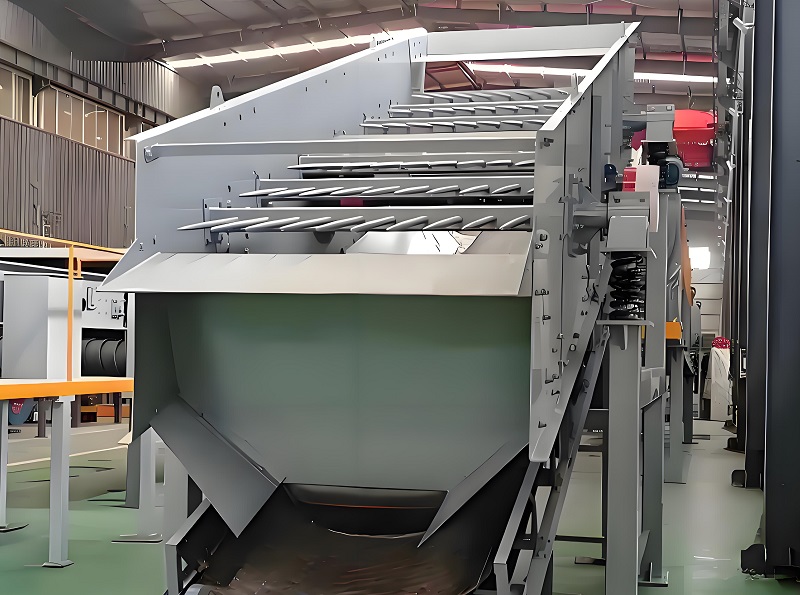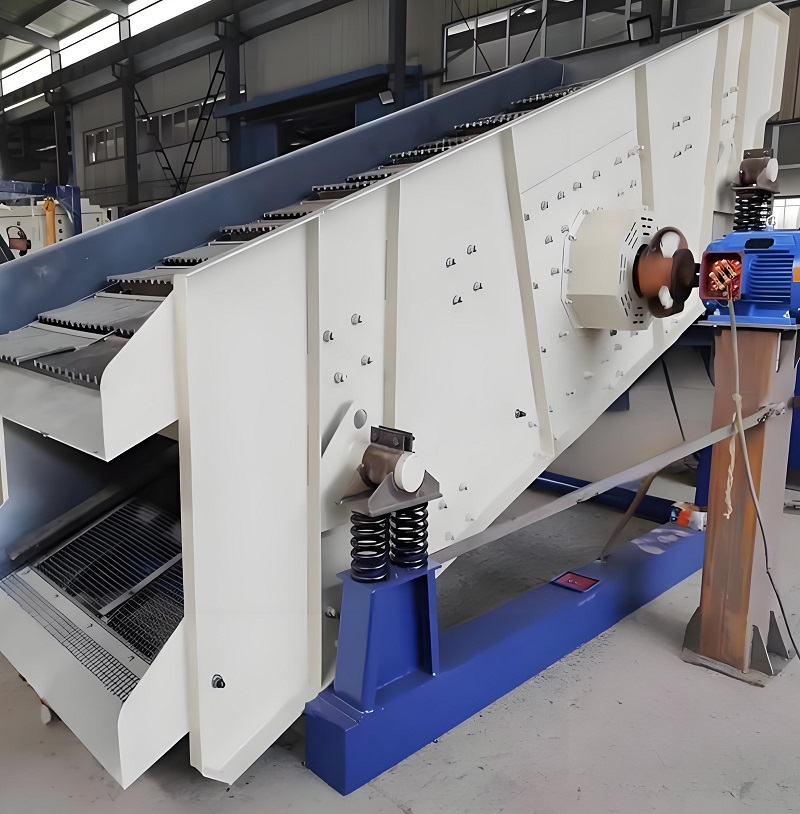In industries such as mining, construction, and chemicals, screening is a crucial step in ensuring production efficiency and product quality. However, traditional screening equipment often faces problems such as insufficient processing capacity, easy clogging, and poor adaptability. Bar screens, as high-efficiency screening equipment, address these industry pain points with their unique advantages, playing a vital role in material pretreatment and grading. This article will delve into the core functions and significant features of bar screens, providing a reference for enterprise equipment selection and production optimization.
A. Core Functions of Bar Screens: Empowering High-Efficiency Screening in Multiple Industries

1. Material Pretreatment: Removing Large Impurities to Ensure the Safety of Subsequent Equipment
In the mining industry, bar screens are key pretreatment equipment before ore crushing. Raw ore often contains large rocks, mud clumps, and other impurities. If these directly enter the crusher, they can easily cause equipment blockage, blade wear, and even shutdown failures. Bar screens, through the setting of screen bars with specific spacing, can separate out large impurities that exceed the particle size limit, allowing only ore that meets the crushing requirements to enter the next stage. Taking coal mining as an example, it can effectively screen out coal gangue with a diameter exceeding 300mm, increasing the crusher's processing efficiency by 25% while reducing equipment failure rate to below 3%. In construction aggregate production, it can filter out large waste materials such as concrete blocks and rebar ends, preventing damage to precision equipment such as sand making machines and grinding mills, and extending the service life of subsequent equipment by 3-5 years.
2. Grading and Screening: Achieving Material Separation by Particle Size to Meet Production Needs
Based on the differentiated particle size requirements of various industries, bar screens can accurately achieve grading and screening. In the sand and gravel industry, by adjusting the bar spacing, different specifications of sand and gravel aggregates such as 5-10mm, 10-20mm, and 20-30mm can be separated, meeting diverse needs such as construction sand and road paving aggregates. After introducing bar screens, a large sand and gravel plant increased the aggregate grading qualification rate from 85% to 98%, significantly enhancing the product's market competitiveness. In the chemical industry, for granular raw materials, bar screens can screen out uniform particles that meet reaction requirements, removing excessively large or small impurities to ensure complete chemical reactions and improve product purity. For example, in fertilizer production, the screened raw materials increase the uniformity of fertilizer particles by 20%, effectively reducing fertilizer agglomeration.
3. Dehydration and Impurity Removal: Separating Moisture and Light Impurities from Materials

In wet sand making and mineral processing, materials often carry large amounts of moisture and light impurities such as mud and dust. Bar screens can effectively dehydrate and remove these impurities. During the screening process of wet sand, moisture and fine mud powder permeate through the gaps in the screen bars, achieving sand dehydration and reducing the sand's moisture content from over 20% to below 10%, facilitating subsequent drying, storage, and transportation. In mineral processing, after ore washing, bar screens can separate the mud-water mixture from the ore, reducing the consumption of mineral processing reagents by impurities and improving mineral processing efficiency. After applying bar screens, a mineral processing plant reduced its reagent consumption by 15% and increased metal recovery by 5%.
4. Protecting Critical Equipment: Reducing Subsequent Process Load and Improving Overall Production Efficiency
In industries such as waste treatment and biomass energy, bar screens can serve as front-end protection equipment, reducing the load on subsequent processes. In municipal solid waste incineration, bar screens can remove large pieces of waste (such as furniture fragments and discarded appliance casings), preventing them from entering the incinerator and causing grate jamming and incomplete combustion, ensuring stable incinerator operation and increasing incineration efficiency by 10%. In the field of biomass power generation, it can filter large impurities and metal foreign objects from biomass feedstocks, preventing them from damaging the biomass boiler's feeding system and furnace, reducing boiler maintenance frequency, and extending continuous operation time to over 300 days.
B. Significant Features of Bar Screens: Supporting Highly Efficient and Stable Operation

1. Reasonable Structural Design and High Durability
Bar screens adopt a modular structural design, mainly composed of a screen frame, screen bars, vibration device, and shock absorption system. The screen frame is welded from high-strength steel, possessing strong resistance to deformation and capable of withstanding impact loads from large materials, maintaining stability even under heavy-duty conditions with a daily processing capacity exceeding 1000 tons. Various screen bar materials are available, including wear-resistant alloy steel, high-manganese steel, and polyurethane, depending on the material characteristics. High-manganese steel screen bars have a hardness exceeding HRC55, offering excellent wear resistance and a service life 2-3 times longer than ordinary steel screen bars. Polyurethane screen bars possess acid and alkali resistance and corrosion resistance, making them suitable for highly corrosive environments such as chemical and metallurgical industries. Furthermore, the screen bars are bolted or embedded, facilitating easy replacement; replacing a single screen bar takes only 15-30 minutes, significantly reducing maintenance downtime.
2. High Screening Efficiency and Strong Processing Capacity: The bar screen generates high-frequency vibration through a vibrating motor or exciter, causing the material to jump across the screen surface, accelerating material stratification and passage speed, significantly improving screening efficiency. Its vibration frequency can be adjusted according to material characteristics (generally 800-1500 r/min), and the amplitude is controlled within 3-8 mm, ensuring that the material is sufficiently loosened while avoiding excessive vibration that could cause material splashing. Compared with traditional fixed screens, bar screens improve screening efficiency by 30%-50%, with a processing capacity of 50-2000 tons/hour, meeting the production needs of enterprises of different sizes. In a large-scale metal mine beneficiation project, after adopting bar screens, the ore screening efficiency increased from 60% to 85%, and the daily ore processing capacity increased by 500 tons.
3. Wide adaptability and flexible adjustment: The bar spacing of the bar screen can be flexibly adjusted according to actual needs, ranging from 5 mm to 500 mm, adaptable to the screening of various materials such as ore, sand, gravel, waste, and biomass. Furthermore, it offers diverse installation methods, including inclined, horizontal, and suspended installations, adapting to different site space and process layout requirements. Inclined installation (generally at an angle of 15°-25°) utilizes the material's own gravity to accelerate conveying speed, suitable for large-volume, easily screenable materials. Horizontal installation is suitable for scenarios requiring high screening accuracy, reducing particle size deviation caused by inclined conveying. Furthermore, bar screens can be seamlessly integrated with crushers, conveyors, dust collectors, and other equipment to form complete production lines, meeting the process requirements of various industries.

4. Stable operation and low maintenance costs: Bar screens are equipped with a high-efficiency vibration damping system, using spring or rubber damping devices, which effectively absorbs vibration energy, reducing vibration interference to the foundation and surrounding equipment during operation, lowering noise (operating noise controlled below 85 decibels), and improving the working environment. Its transmission components have a simple structure and low failure rate; the main wear parts are the screen bars, resulting in low replacement costs. Daily maintenance only requires periodic checks of screen bar wear and lubrication of the vibration device bearings, minimizing maintenance workload. According to industry statistics, bar screens have an average mean time between failures (MTBF) of over 8000 hours, with annual maintenance costs only 5%-8% of the total equipment cost, far lower than other types of screening equipment.
5. Strong anti-clogging capability, adaptable to complex materials. For moist and highly viscous materials, bar screens feature a special design to enhance their anti-clogging capability. Some bar screens use trapezoidal or wedge-shaped screen bars with smooth surfaces, reducing material adhesion. Simultaneously, the strong vibration generated by the vibrating device continuously shakes the screen bars, dislodging materials stuck in the gaps and effectively preventing clogging. When processing clay ore with high moisture content, traditional screening equipment has a clogging rate exceeding 30%, while bar screens can control the clogging rate below 5%. Furthermore, for materials containing many impurities and foreign objects, the large gaps in the bar screen bars are less likely to be jammed by large pieces of material, ensuring continuous and stable operation of the equipment. This makes them particularly effective in complex material handling scenarios such as waste treatment and construction waste recycling.
Bar screens play a crucial role in industrial screening, enabling material pretreatment, grading, dewatering, impurity removal, and protection of downstream equipment, thus improving efficiency across multiple industries. They are characterized by durable structure, high screening efficiency, wide adaptability, low maintenance costs, and strong anti-clogging properties, allowing them to adapt to complex working conditions. Whether in mining or waste treatment, bar screens operate stably, reducing costs and increasing efficiency for enterprises, making them an indispensable piece of equipment in industrial production.